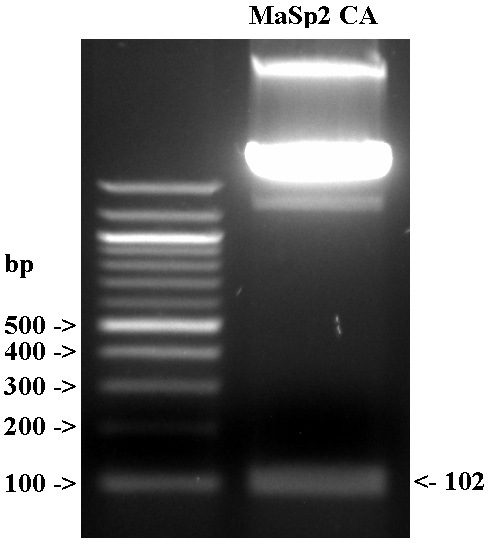Team:UCLA/Notebook/Spider Silk Genetics/25 June 2015
Contents
6/25/2015
To-Do Plan
- set up IABCT, IT and verify on gel (maybe e-gel)
- amplify using post-elution primers.
- verify this on gel too,
- If both of these work, then bind the first IABCT to beads. Wash, then elute, then attempt amplification.
- This will test whether the beads can bind to the biotin or not.
Making IABCT and IT
- General scheme: Assemble IAB and CT, then combine both together.
- Here is the concentrations of all ICA pieces used in this experiment.
| Concentration | Volume Used (uL) | |
|---|---|---|
| AB | 41.5 ng/uL | 1.2 |
| BC | 54.3 ng/uL | 0.93 |
| CA | 15.1 ng/uL | 3.3 |
| Initiator | 5 uM | 1 |
| Terminator | 5 uM | 1 |
- Here is the scheme for assembling the pieces.
| IAB | CT | IT | |
|---|---|---|---|
| I | 1 uL | 1 uL | 1 uL |
| A | 1.2 uL | n/a | n/a |
| B | 0.93 uL | n/a | n/a |
| C | n/a | 3.3 uL | n/a |
| 2x T7 Ligase Buffer | 5 uL | 5 uL | 5 uL |
| T7 Ligase | 0.5 uL | 0.5 uL | 0.5 uL |
| ddH2O | 1.39 uL | 0.2 uL | 2.5 uL |
| Total | 10 uL | 10 uL | 10 uL |
- Incubated 25 C for 10 min.
- Combined IAB and CT, incubated 25 C for 10 min.
Making IABCT results
- Cast 1.5% TAE gel; 2 uL of 100 bp ladder.
- Ran 10 uL of IABCT.
- Ran 5 uL of CT, diluted to 10 uL.
- The IABCT construct can be successfully generate without using beads. We will try incubating the leftover IABCT solution onto the streptavidin beads.
- In the IABCT sample, there is also IT present due to leftover IT that was subsequently ligated. This IT may bind onto the beads as well.
PCR Amplification with Post-Elution Primers
- Testing to see if the post-elution primers can be used to amplify IABCT, IT, prior to testing on beads.
- Set up one 25 uL reaction each for IABCT, IT from earlier.
| IABCT | IT | |
|---|---|---|
| 5x Q5 Buffer | 5 uL | 5 uL |
| 10 mM dNTPs | 0.5 uL | 0.5 uL |
| 10 uM For | 1.25 uL | 1.25 uL |
| 10 uM Rev | 1.25 uL | 1.25 uL |
| Template | 1 uL | 1 uL |
| Q5 Polymerase | 0.25 uL | 0.25 uL |
| 5x GC enhancer | 5 uL | 5 uL |
| ddH2O | 10.75 uL | 10.75 uL |
| Total | 25 uL | 25 uL |
| 98 C | 30 sec |
|---|---|
| 98 C | 10 sec |
| 66 C | 15 sec |
| 72 C | 20 sec |
| repeat from step 2 | 20x |
| 72 C | 2 min |
| 12 C | hold |
IABCT, IT can be amplified with Post-elution primers
- Cast 1.5 % TAE gel. 2 uL of 100 bp ladder.
- The amplification of IABCT is not very strong due to competition from the IT that is also present in the mixture.
- BUT we show that post-elution amplification is possible. At this point, we will bind the IABCT and IT onto the streptavidin beads.
- If amplification does not work, then it is most likely a problem with bead binding.
IABCT, IT amplification with beads
- 10 uL of magnabind beads.
- washed 2x using 100 uL 2x BW buffer.
- Added 5 uL of 2x BW buffer, and 5 uL of relevant DNA (IABCT or IT).
- Incubate 45 min at RT (~23 C) with rotation.
- Removed and saved supernatant.
- Washed 2x in 0.5x BW buffer.
- Elute at 95 C for 5 min uisng 0.01% Tween-20, with occasional mixing.
- PCR amplify bead eluate and post-incubation supernatant in 25 uL reactions.
- use 2 uL of each sample as template.
- same temperature cycle as above section, but with 25x cycles.
- Visualize on 1.5% TAE gel, with 2 uL 100 bp ladder.
- The results show that the beads bind all of the present biotinylated DNA. Subsequent calculation show that the beads are in excess.
- IT is amplified from both bead elutions, but IABCT is not amplified.
- This result is confusing. May be due to selective amplification of IT.
BsaI Digestion of MaSp2 CA
- We digested more CA monomers.
- Digested 5 ug of 2CA plasmid in 50 uL reaction using 4 uL BsaI.
- Incubated 50 C for 2 hours, then heat killed at 65 C for 20 min.
- Ran on 1.5% TAE gel to visualize; used 2 uL NEB 100 bp ladder.
- We excised and gel extracted the 102 bp band using qiagen's kit.
- 23.66 ng/uL for the final concentration.




